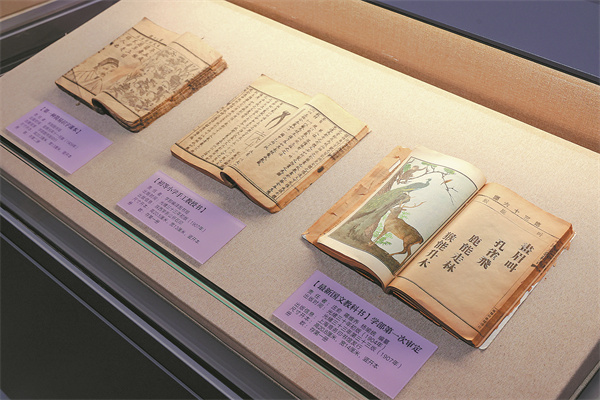

Diverse styles
Since 1912, following the downfall of the Qing Dynasty, fine arts education continued to evolve with the times, viewed as a period of exploration.
In 1917, educator Cai Yuanpei (1868-1940) proposed to "replace religion with aesthetic education", highlighting the role of fine arts education in cultivating noble characters by nurturing people's emotions, transcending the earlier perception of fine arts education solely as a way of imparting practical skills during the Qing Dynasty.
The colorful covers of fine arts textbooks in the 1930s and 1940s on display reveal the growing impact of foreign culture. This influence has contributed to diverse painting styles, resulting in the development of textbooks covering a broad spectrum of arts, including pencil drawings, brush paintings, crayon drawings, pen drawings and watercolor paintings, says Li Hongbo.
Even during the turbulent times of the War of Resistance Against Japanese Aggression (1931-45) and the War of Liberation (1946-49), basic fine arts education was not abandoned.
Also in the exhibition is a fine arts textbook used from 1938 to 1945 by schools in Huixian county, Henan province, run by the Eighth Route Army led by the Communist Party of China.
"It's a rare exhibit, telling us even in difficult times, Chinese people did not give up fine arts education. Teachers and art professionals drew to promote the revolution, and children painted their aspirations for a better life, laying a solid foundation for the development of fine arts in New China," Li Hongbo says.
Since the founding of New China in 1949, fine arts education has developed rapidly. The syllabuses and curriculum standards of the subject have improved with changes of ideas about the role of fine arts.
In 2022, the latest art curriculum standards for compulsory education were issued with the aim of nurturing hearts and guiding students to perceive, experience and understand art in aesthetic practices. Last year, guided by the standards, the latest fine arts textbooks were published across the country, as shown in the exhibition.
Li Hongbo also highlights the significance of regional textbooks as supplements to their official counterparts. These books feature local characteristics and initially emerged in the 1980s to address the shortcomings of official educational materials.
For example, at that time, some students from southern China had never seen snow and found it hard to draw snowy landscapes. Also, students from northern China did not have the concept of a coconut tree since they had never seen one.
"Regional textbooks often utilize local landscapes and cultural elements as educational tools to showcase the unique cultural resources of a particular region, serving as a complement to the national standard textbooks. Both types of textbooks have run concurrently and have evolved into essential models in our foundational fine arts education," says Li Hongbo.